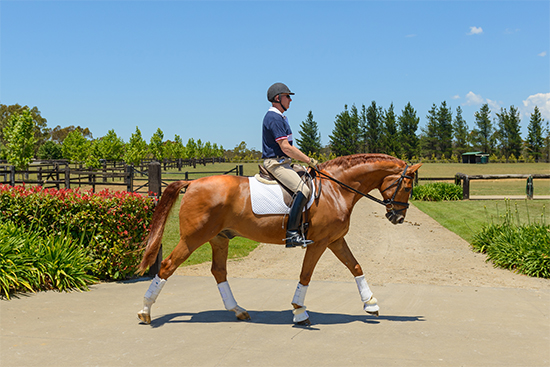 Story: Suzy Jarratt & Photos: Cameron Grant
Story: Suzy Jarratt & Photos: Cameron Grant
This quiet little hamlet in the NSW Southern Highlands boasts a very large potato in its main street – a 10 metre long Sebago to be precise. Robertson’s other features include waterfalls, forests, a coterie of notable residents – and Wallaby Hill Farm.
Overlooking Kangaroo Valley this exceptional equestrian facility was the venue for a three day clinic conducted in November by Hayley Beresford. Permanently based in Germany at the Zucht und Sportpferde Schmidt in Lipppetal, Hayley took a break from the 20 horses she has there in training to conduct clinics along Australia’s east coast.
Young, green horses, seasoned competitors and everything in between all benefited from her coaching.
As stated in the Gerd Heuschmann feature in THM’s December 2012 issue: “A trainer’s job is to reduce anxiety, establish a positive mood and execute a systematic training plan.” Hayley did just that.
“She’s improved every horse with her clear, concise explanations” said Equisport’s Camilla ‘Bird’ Palmer, one of Hayley’s sponsors and clinic organiser. “She’s helped me to put my gelding into a really correct frame. As with all the horses here she works on the silhouette.”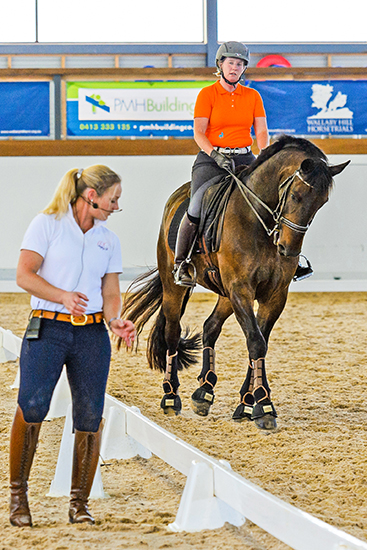
Glenquarry (Ilkay/Stirling Lilac), Camilla’s small tour horse, has had several riders over the years when Camilla took time off to have babies.
One of his problems was curling up as if he was being deliberately rollkurred. And this was compounded after having time off with a virus.
“He’d lost strength in his back and would continually put himself behind the vertical. And he had a tendency to run.”
“That running comes from a lack of balance,” observed Hayley, who also reprimanded Camilla, and other riders, for making shoulder-in from her inside rein.”
Camilla worked on getting the nose forward and within half-an-hour ‘Lenny’ was up and looking good.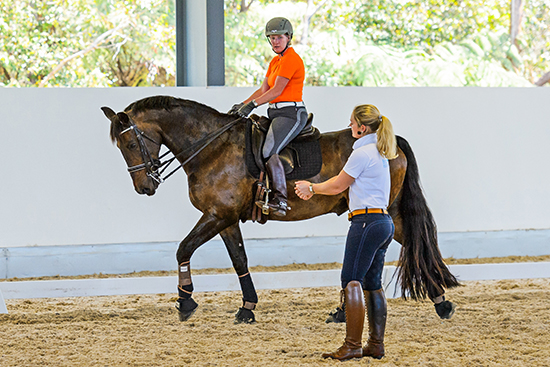
“So many clinics result in the riders saying ‘O.K. but I can’t do all that all on my own. I’m going to make a complete and utter mess of it’. Here you can walk away with something to work on – and no horse is unhappy after a session.”
She’s not yet four but Ribbleton Finesse, by Fishermen’s Friend, was clearly a happy Hanoverian when working with Hayley. Her rider, Priscilla Blackadder, a Sydney-based copyright barrister, has had a long held dream to work with Hayley in Germany which she shortly hopes to realise.
Priscilla is 31 and for at least 25 of those years she’s good naturedly put up with people asking about her cunning plan and the whereabouts of Baldrick.
“I should have named a horse that,” she mused, “but someone had already done so. I did have one called D’Artagnan but that’s another story altogether.”
She found Hayley’s message during her lessons to be very clear:
“Focus on the basics and don’t bring the tricks in too early. My mare has a natural ability to collect but I was told not to take anything for granted at this early stage. Anything that’s given I’m to take as a gift but don’t ask and don’t drill it.”
Hayley had ridden the young horse the previous day and had been very complimentary about the mare’s conformation and attitude. Her instructions during the Sunday session were: “just go forward, straight and into the contact – don’t worry about the roundness”.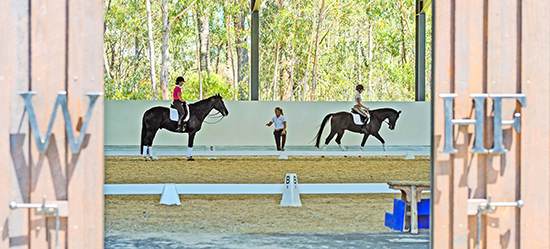
Priscilla added: “This clinic’s been fantastic, a big learning curve for everyone. I’m so looking forward to visiting Hayley when I’ll be riding a schoolmaster, I hope to be away for several months.”
Hayley, originally from Narrogin, WA, has always encouraged young Australians to work with her. Presently at Lippetal three are permanent.
“And I have a rotational position open for three months at a time where I give them one of my Prix St Georges horses, they have private lessons and come to the shows.”
Her two senior riders are Bella Robson from WA and Ben Terry from Victoria, both training up to Grand Prix, and then there’s Genevieve Kirk who commutes between Switzerland and Australia with her family.
“She’ll be coming on the international young riders’ tour in 2013 with some very exciting horses and she’ll travel with me to the shows.”
Eleven-year-old Waitano has been to many shows and was one of the more advanced horses in the clinic. By Wolkentanz out of Wanderbursch ‘Teddy’ has been purchased by Carolyn Lieutenant, now living in Bowral. Ridden by Jayden Brown during the National Dressage Championships the handsome Hanoverian was originally imported from Germany by the Dowsett family for their daughter Danielle who no longer competes.
“Having horses in competition is my interest. I like being an owner,” declared Carolyn. “I’ve been watching Mark Kiddle and decided he needed a good horse. He’s a good rider and lives only 10 minutes from me.”
Mark and partner Malcolm MacRae, run a yard that is part of Katharine Olsen’s property in Mittagong.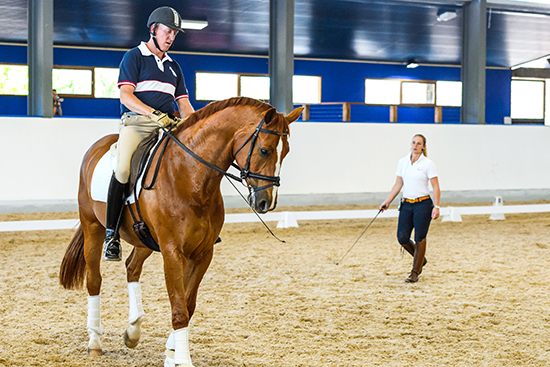
Mark’s assessment of his lessons was a very positive one:
“I’ve ridden at clinics with many, many different trainers and she’s the best I’ve had.”
Teddy’s suppleness was a priority.
“He’s blocked and needs a few months’ work to get him unstuck,” said Hayley. “And he’s too straight during the shoulder-in. Play with the gearbox. Show him how to use his body.”
“Horses are flexible where the girth is so don’t have your legs so far back.”
Mark had only had him for four weeks prior to the clinic.
“He can get a bit strong and stiff,” he said. “He needs to be a lot more supple through the neck but we knew that when we bought him.”
And is he a typical redhead? So many chestnuts have a reputation of being feisty, tending to behave like Ginger Rogers on crack…
“Not Teddy – he’s amazing and forgiving. The work we’ve done here has been simple and easy because much of it was along the same lines as Carolyn.”
“Hayley emphasised the importance of looking after the outside hindleg; being more connected through the outside. It really worked with Teddy.”
“He can get very fixed. On the first day of the clinic he was very much like he was when we took him out to an event. I think he came in and thought ‘I’m at a competition’ and goes a little bit wooden. Today, the second session, he was much better. Yesterday I rode Katharine’s Lusitano stallion, Venturoso, who’s nearly ready to go out Prix St Georges.”
Mark feels many Australian dressage judges don’t know how to assess this breed but he loves Iberian horses as does Mrs Olsen. Her husband, John, the legendary artist, has little to do with them and is busy painting. He recently told The Newcastle Herald he had a large mural to complete:
“Like the rest of Australia my enemy is the ATO but we’re just about to start a huge commission for the foyer of Melbourne’s new taxation office – it’s called ‘Reconciliation’,” he chuckled.
Mark’s knowledge of high finance is not considerable but he does know a lot about Iberian horses.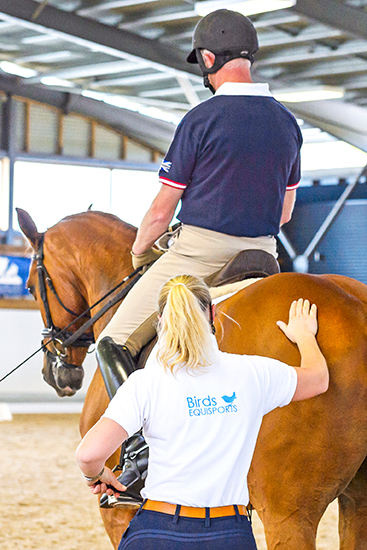
“I rode them when I worked for Jose Mendez for quite a few years and also at El Caballo Blanco. They gave me a completely different perspective on dressage. Being on horses which could do pirouettes and one time changes was invaluable.”
Undoubtedly all clinic participants received invaluable assistance from this tireless 34-year-old trainer who encouraged riders to watch each other’s lessons.
“Often I’ve told them the same thing as the rider in the arena and it’s beneficial they see what’s required to fix the problem. They can observe the biomechanics – this is why I want you to use more outside rein because you can see that now the outside hindleg is more articulated, it’s more under the centre of the horse and that the horse is more in self-carriage.”
Over the years Hayley has made regular visits to Australia except in 2011 when she was working towards the Olympics.
“I was concentrating on the Grand Prix horses, however the selectors didn’t want me so I didn’t go.” She describes this time as ‘lines in the sand’.
“Anyway this is now and I’m just finishing my sixth day of coaching – I did some in Melbourne prior to coming to Wallaby Hill.’
“Everyone has improved, everyone is still super enthusiastic but what I do see is that people are trying so hard to bend and flex and make their horses round they’re tending to disrupt the balance.”
“I’ve always believed you need to have the back and the middle of the horse really supple. A lot of riders are overflexing their horses without balancing them correctly behind. That’s my biggest criticism but it’s something which is really simple to fix.”
And she watches the ears which most trainers say are to be kept level.
“I go to the extreme and tell them ‘keep the outside ear down’. I don’t mean tilt the head but when I say keep control of the outside ear riders keep a better connection on the outside rein.”
“Another thing I say is ‘sit floppy’. They shouldn’t take me literally and resemble a sack of potatoes but it’s an expression meaning ‘relax’, which works well for everyone in this clinic.”
“Dressage must look beautiful, harmonious and easy.”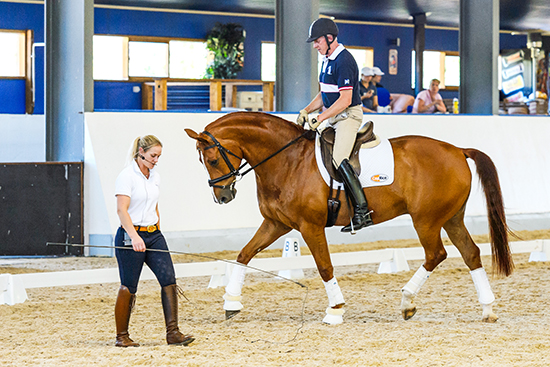
“I’ve made a million mistakes with the many different types of horses I’ve trained – more than ten to Grand Prix – but I’m so excited at the moment about my own riding, learning to let a horse go in that silhouette when they can engage, carry and have balance. It’s amazing how much happier they become to do everything. With ‘Basti’, for example, who was a bit aggressive and feisty, he was missing four vertebrae. He needed to be able to stretch and go in that silhouette. I want to encourage this harmony because it’s really the future of the sport.”
‘Basti’ is Bev Edwards’ Jaybee Alabaster formerly ridden by Rachael Downs. This combination went to Europe as Olympic contenders but it was not to be.
As reported in Eurodressage: ‘they looked to be a certainty for London selection. However, it was well documented that supposed foot problems associated with shoeing caused the horse to be withdrawn from Olympic selection’.
Rachael returned to Australia while the 13-year-old chestnut remained in Germany. He is now being competed by Hayley.
“It all came about when Caroline Coleby visited me in Germany. She’s a friend of Bev’s and told me the horse was in quarantine at Klatte’s, wasn’t being ridden, he was fat and unfit and his future was undecided. Only a few weeks remained before he had to go home.”
Hayley decided to try him.
“I had a short time in which to assess the situation and make a suggestion as to what could be done. All I knew is that Bev wanted an Australian rider on the horse. After I picked him up I rode him and I liked him. And he was completely sound.”
There was a rumour he had undergone a neurectomy.
“What’s a neurectomy?” asked Hayley. “We took him to the vet, not really knowing what the problem had been. I suggested to Bev we got him shod at our clinic where our farrier is based. My highest trained horses are all shod in conjunction with the veterinary clinic. It has a farrier attached and they work together. We X-rayed the front and he was shod from the X-rays. And so far, so good. He’s on a Hi-Form program, who are one of my sponsors, he gets Adequan and Tildren and he’s shod at the clinic every five weeks.”
“I feel he just wasn’t acclimatised; he’s a very sensitive guy. I’ll defend the horse to the hilt here because I really don’t think he’s got any problems.”
In September she took him to a CDI-W in Wroclaw, Poland. They came third in the Inter 11 (66.606%) and sixth in the GP (67.957%).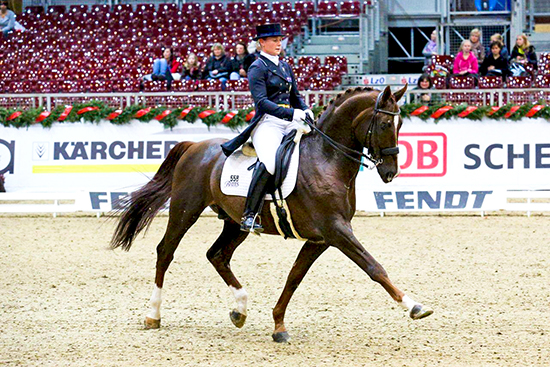
Hayley and Jaybee Alabaster (Photo: Goran K Josefsson)
“It was a little early but the deadline for quarantine was coming up and I wanted to see how he’d be at a competition – he’d looked difficult in Mannheim.”
“I wasn’t totally satisfied. There were a lot of things I had to figure out. He got decent marks because he did everything in the right place but there wasn’t any harmony or partnership. And there was another show after that which people didn’t know I’d been to because I pulled him out of the event. I didn’t have him on my side and I took him home.”
Over the following weeks Hayley came to understand this horse and how to effectively manage him. He’s had acupuncture, Chinese medicine, work done on his back, been hacked out, jumped, taken over ground poles and galloped around a track.
“He gets to be a horse. To be completely honest we’ve bribed him. When working on the half steps Ben’s been behind me, like I’ve been with some of the riders at this clinic, and in front there’s Bella with a bucket of apples. Basti thinks it’s the coolest game he’s ever played!”
Prior to competing in Oldenburg in early November she rode him without spurs in a snaffle
“Before that event I’ve never had a horse which piaffed/passaged like he did. It was so cool.”
And it was a personal best for Hayley where she came second in the Special with 72.467%. She placed fifth in the GP with 69.936%.
She has always known that the horse is for sale.
“I’ve asked Bev to give me a bit of time to raise some money so I can keep him for the next few years. She’s prepared to take a half share. I’ll be seeing her after this clinic when I’ll ride some of her young horses.
“And on the subject of young horses I have to say just how impressed I’ve been with those which have been in these clinics. I’ve told their riders to train them according to the German training scale – speed, control, balance, straightness, connection – in that order.
“There’s no doubt that when it comes to bringing up young saddle horses Australian horsemanship leads the way – it’s just that as they mature training techniques can go a little wrong.”
Hayley better return soon and ensure this doesn’t happen.
This article first appeared in the February 2013 issue of THM.


